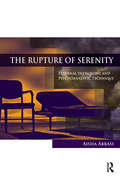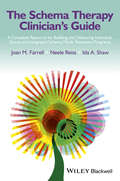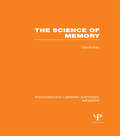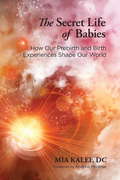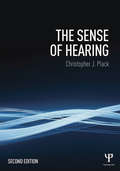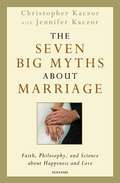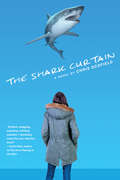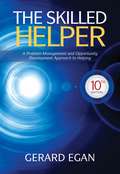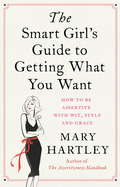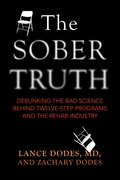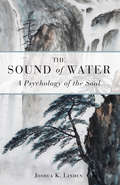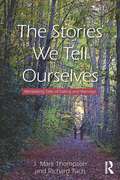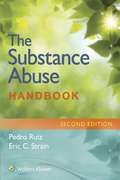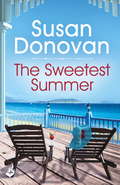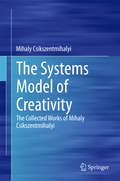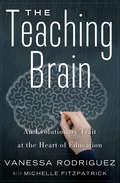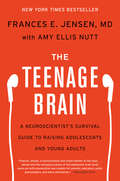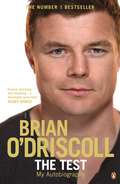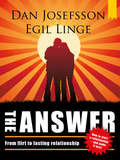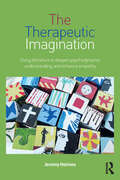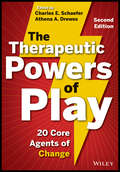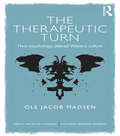- Table View
- List View
The Rupture of Serenity: External Intrusions and Psychoanalytic Technique
by Aisha AbbasiWhat happens when the outside world enters the psychoanalytic space? In The Rupture of Serenity: External Intrusions and Psychoanalytic Technique, the author draws on clinical material to describe some of the dilemmas she has encountered in her work with patients when external factors have entered the treatment frame. She considers analytic dilemmas that range from how to deal with patients' unusual requests regarding the conduct of an analytic treatment to the question of how to handle events in the analyst's personal life that, by necessity, must be addressed in the analysis. As a Muslim of Pakistani origin, the author is also able to discuss, frankly and with compassion, the role that ethnic and religious differences between patient and analyst can play in treatment-differences that, in the aftermath of 9/11 and the search for and killing of Osama bin Laden, became a palpable presence in her consulting room.
The Schema Therapy Clinician's Guide
by Neele Reiss Ida A. Shaw Joan M. FarrellThe Schema Therapy Clinician's Guide is a complete clinical resource for psychotherapists implementing schema therapy, group schema therapy or a combination of both in a structured, cost-effective way. The authors provide ready-made individual and group sessions with patient hand-outs. A unique resource providing ready-made individual and group schema therapy sessions, linked across schema modes, allowing clinicians to pick and choose what they need or adopt a full integrated individual and group program which can be delivered over a range of treatment lengths from a six week intensive program to a one year outpatient treatmentApproaches treatment by targeting maladaptive Schema Modes rather than specific disorders, thus increasing clinical flexibility and ensuring shelf life through changes in diagnostic classificationProvides step-by-step instructions and tips for therapists, along with a wealth of unique clinical resources including sample scripts, handouts, session exercises, assignment forms and patient materialsMeets the current need for effective clinical treatments that can provide tangible effects on time and on budget
The Science of Memory (Psychology Library Editions: Memory)
by David KayOriginally published in 1902, this title was discovered as a manuscript after the author’s death and was published 4 years later. David Kay published articles on various subjects and was one of the sub-editors on the eighth edition of Encyclopaedia Britannica. After writing an article on mnemonics he became very interested in the subject of memory. He had already published a title in 1888, Memory: What It Is, and How to Improve It, and this volume was intended to build on that discussion. A great opportunity to read one of the early discussions on human memory.
The Science of Psychology (Third Edition)
by Laura A. KingFocusing on why things go right, The Science of Psychology: An Appreciative View, Third Edition, helps students understand and appreciate psychology as a science and as an integrated whole. The third edition's program extends the themes and enhances the pedagogical value by guiding students toward topics they find the most challenging and then offering new learning resources to help students master them.
The Science of Psychology: An Appreciative View (AP Science of Psychology Ser.)
by Laura A. KingNIMAC-sourced textbook
The Secret Life of Babies
by Mia Kalef Andrew FeldmarA bold affirmation that we are sentient before conception and in the womb, The Secret Life of Babies reveals author Mia Kalef's groundbreaking findings: babies are able to remember their earliest experiences, this consciousness precedes the physical development of the brain itself, and medical interventions during birth--like forceps and Cesareans--can imprint our relationships with the world and disconnect us from our sustainable place in the ecosystem. Kalef provides a six-step protocol for detecting these individual imprints and taking reparative steps for physiological and emotional balance and release. This book offers us an articulate guide to a transformation that can restore our essential nature. From the table of contents:Foreword by Andrew FeldmarIntroduction: The Myth: Science and Experience The Quest: Sparking the Conversation Who Is This Book For? A Song Worth SingingPART ONE: ScienceChapter 1: The First Principle: Babies Remember Their Experiences The Controversy A Place to Begin and End: Returning to Wholeness Essential Nature Essential Movements The Mechanisms The Model Perspectives and PurposesChapter 2: The Second Principle: Consciousness Precedes the Brain Architecture That Supports It The Biological Paradox Brains, Fields, and Development The Effects of Chemical and Emotional FieldsChapter 3: The Third Principle: Babies Are Our Barometers Dominance versus Emergence Historical Cultural Indicators Present-Day Cultural IndicatorsPART TWO: ExperienceChapter 4: The Fourth Principle: It Is Never Too Late to Heal The Vision Horizon Preparing the Way Reclaiming the Body: The Path Home The PrototypePART THREE: MarriageChapter5: The Intuitive Recovery Project The Anatomy of the Intuitive Recovery Project The ProjectChapter 6: SummaryFrom the Trade Paperback edition.
The Sense of Hearing
by Christopher J. PlackThe Sense of Hearing is a truly accessible introduction to auditory perception that is intended for students approaching the subject for the first time, and as a foundation for more advanced study. The second edition has been thoroughly revised throughout, and included new chapters on music, hearing impairment, and a new appendix describing research methodologies. In clear and authoritative prose, the fundamental aspects of hearing are addressed. The reader is introduced to the nature of sound and the spectrum, and the anatomy and physiology of the auditory system. Basic auditory processes including frequency selectivity, loudness and pitch perception, temporal resolution, and sound localization are explained. The reader is led to an understanding of the remarkable abilities of the auditory system in a systematic and coherent way. In subsequent chapters, it is shown how complex processes, such as perceptual organization, speech perception, and music perception, are dependent on the initial analysis that occurs when sounds enter the ear. Finally, a chapter on hearing impairment provides an introduction to disorders of the auditory system.The text benefits from 162 original illustrations, including uncluttered diagrams that illuminate auditory mechanisms. An extensive glossary provides definitions of technical terms. The emphasis is on explanation and clarity of style throughout, making The Sense of Hearing an essential resource for students and educators involved in this sometimes challenging field.
The Seven Big Myths about Marriage: What Science, Faith, and Philosophy Teach Us about Love and Happiness
by Christopher Kaczor Jennifer KaczorThis work explores some of the most interesting and vexing issues concerning contemporary marriage, including contraception, reproductive technology, and divorce. Appealing to reason rather than religious authority, the book tackles the most controversial and talked about moral teachings of the Catholic Church and argues for their reasonableness.
The Shark Curtain
by Chris ScofieldWinner of the 2016 Paterson Prize for Books for Young People"It's easy to empathize with [Lily]....Throughout, first-time author Scofield creates striking images that will stay with readers."--Publishers Weekly"This is a painful and poignant story that is not for every reader; but for those ready to deal with complex realistic fiction, it has much to offer."--Booklist"Dynamic...[Protagonist Lily Asher] comes to glorious, heartbreaking, embraceable, vibrant life courtesy of the experiences, heart and immense imagination and talent of Eugene author Chris Scofield."--The Register-Guard"Chris Scofield has written a young adult novel that doesn't compromise integrity for trendiness....It's complex and quirky...there can be no doubt as to its uniqueness."--LitReactor"The Shark Curtain is worth a read by teens and adults alike."--Eugene Weekly"Absolutely bewitching....Scofield has crafted a dense, poignant book, filled with extraordinarily beautiful language....In exploring themes such as art, sex, and self-acceptance, Scofield examines the trade-offs we all make to be included in the tribe."--KLCC"Those who prefer edgy period fiction with truly original characters will be fascinated by this glimpse into the mind of an unmedicated non-neurotypical teen struggling to come of age in the '60s."--The Bulletin of the Center for Children's Books"The Shark Curtain...is believable and real."--What Is Much"Brilliant, engaging, engulfing, fulfilling, beautiful. The Shark Curtain will turn you inside out and make you see the world differently. As well you should. As well we all should. Because life isn't about having the answers, it's about grappling with the questions. Chris Scofield's fantastically fantastic novel pins the tail on the donkey with a pneumatic nail gun--I absolutely insist that you read this book!"--Garth Stein, New York Times best-selling author of The Art of Racing in the RainSet against the changing terrain of middle-class values and the siren calls of art and puberty, The Shark Curtain invites us into Lily Asher's wonderful, terrible world. The older of two girls growing up in suburban Portland, Oregon, in the mid-1960s, her inner life stands in quirky contrast to the loving but dysfunctional world around her.Often misunderstood by her flawed but well-intentioned parents, teenage Lily orbits their tumultuous love affair, embracing what embraces her back: the ghost of her drowned dog, a lost aunt, numbers, shoe boxes, werewolves, rituals, and stories she pens herself (including one about a miscarried sibling she dubs "Frog Boy"). With "regular" visits from a wisecracking Jesus, an affectionate but combative friendship is born--a friendship that strains Lily's grasp of reality as much as her patience.From the violence of a Peeping Tom and catching Mom in flagrante delicto with the neighbor, to jungles in her closet, butlers under her bed, and barking in public, Lily struggles to balance her family's expectations with the visions that continue to isolate her.
The Skilled Helper: A Problem-management And Opportunity-development Approach To Helping
by Gerard EganThis book elaborates on the communication skills needed by helpers to engage in a therapeutic dialogue with clients and a detailed overview of the problem-management and opportunity-development process at the heart of helping.
The Smart Girl's Guide to Getting What You Want
by Mary HartleyDo you feel like you're not heard but you don't want to have to scream?Personal development coach Mary Hartley explains the secrets of assertiveness - of how to communicate with other people in ways that are confident, effective - but also considerate. Mary reveals the simple steps you can take to help you relate to other people honestly and openly in every area of your life - at work, with your friends and family and in your love life. You will discover that you can be true to yourself and your needs without hurting or diminishing other people. * What assertiveness is and why it matters * How to avoid aggression, passivity and manipulation * Tips for handling tricky situations including put-downs and dealing with bullies * Mastering assertive body language and communication Packed with practical strategies and exercises, this book will show you how to be confident, assured and proactive - with style.
The Sober Truth
by Zachary Dodes Lance DodesAn exposé of Alcoholics Anonymous, 12-step programs, and the rehab industry--and how a failed addiction-treatment model came to dominate America. AA has become so infused in our society that it is practically synonymous with addiction recovery. Yet the evidence shows that AA has only a 5-10 percent success rate--hardly better than no treatment at all. Despite this, doctors, employers, and judges regularly refer addicted people to treatment programs and rehab facilities based on the 12-step model. In The Sober Truth, acclaimed addiction specialist Dr. Lance Dodes exposes the deeply flawed science that the 12-step industry has used to support its programs. Dr. Dodes analyzes dozens of studies to reveal a startling pattern of errors, misjudgments, and biases. He also pores over the research to highlight the best peer-reviewed studies available and discovers that they reach a grim consensus on the program's overall success. But The Sober Truth is more than a book about addiction. It is also a book about science and how and why AA and rehab became so popular, despite the discouraging data. Dr. Dodes explores the entire story of AA's rise, from its origins in early fundamentalist religious and mystical beliefs to its present-day place of privilege in politics and media. The Sober Truth includes true stories from Dr. Dodes's thirty-five years of clinical practice, as well as firsthand accounts submitted by addicts through an open invitation on the Psychology Today website. These stories vividly reveal the experience of walking the steps and attending some of the nation's most famous rehabilitation centers. The Sober Truth builds a powerful response to the monopoly of the 12-step program and explodes the myth that these programs offer an acceptable or universal solution to the deeply personal problem of addiction. This book offers new and actionable information for addicts, their families, and medical providers, and lays out better ways to understand addiction for those seeking a more effective and compassionate approach to this treatable problem. From the Hardcover edition.
The Sound of Water
by Joshua K. LindenAfter a lifetime of living, Joshua K. Linden heard the sound of water in a whole new way. The mesmerizing, meditative sound resonated so deeply within his soul that it propelled him on a seven year journey of reflection: on soul, ego, and our place within the web of life. What he has discovered during his journey is suffering is a result of the battle between the ego and the Soul. The ego wants to plan and create a future whereas the Soul needs to express itself in the present. If one is truthful, eventually one awakens to the fact that the body will die, and that the future in this dimension is limited. The Sound of Water leads readers to understand it is in their best interest to shed the ego and to live life with the Soul that is eternal. Linden's book points you in the direction of this Source. This is where your essence and the essence of all things flow into one another--without deception, distortion, or corruption. Beautifully designed, The Sound of Water offers a series of thoughts and meditations that will guide you in your own journey to reconnect with the Source. You are invited to read it from beginning to end, or flip to a page at random to find deep insight and wisdom; inspiring you to awaken to living a life that deeply honors and values the Soul.
The Stories We Are
by William RandallFrom time to time we all tend to wonder what sort of "story" our life might comprise: what it means, where it is going, and whether it hangs together as a whole. In The Stories We Are, William Lowell Randall explores the links between literature and life and speculates on the range of storytelling styles through which people compose their lives. In doing so, he draws on a variety of fields, including psychology, psychotherapy, theology, philosophy, feminist theory, and literary theory.Using categories like plot, character, point of view, and style, Randall plays with the possibility that we each make sense of the events of our lives to the extent that we weave them into our own unfolding novel, as simultaneously its author, narrator, main character, and reader. In the process, he offers us a unique perspective on features of our day-to-day world such as secrecy, self-deception, gossip, prejudice, intimacy, maturity, and the proverbial "art of living."First published in 1995, this second edition of The Stories We Are includes a new preface and afterword by the author that offer insight into his argument and evolution as a scholar, as well as an illuminating foreword by Ruthellen Josselson.
The Stories We Tell Ourselves: Mentalizing Tales of Dating and Marriage
by Richard Tuch J. Mark ThompsonThe Stories We Tell Ourselves: Mentalizing Tales of Dating and Marriage is about the dynamics of intimate interpersonal relationships (dating and marriage) - how and why human pairings occur, what helps them function optimally and how therapists can intervene when they don't. J. Mark Thompson and Richard Tuch employ a multidimensional perspective that provides a variety of "lenses" through which intimate relationships can be viewed. The authors also offer a new model of couples therapy based on the mentalization model of treatment developed by Peter Fonagy and his colleagues. This book is aimed at those interested in the nature of intimate relationships as well as those wishing to expand their clinical skills, whether they are conducting one-on-one therapy with individuals struggling to establish and maintain intimate relations or are conducting conjoint treatment with troubled couples who have sought the therapist's assistance. Thompson and Tuch view relationships from a wide array of different perspectives: mentalization, attachment theory, evolutionary psychology, psychoanalysis, pattern recognition (neuroscience), and role theory. A mentalization based approach to couples therapy is clearly explained in a "how to" fashion, with concrete suggestions about how the therapist goes about clinically intervening given their expanded understanding of the dynamics of intimate relations outlined in the book. The Stories We Tell Ourselves: Mentalizing Tales of Dating and Marriage will appeal to psychoanalysts, psychotherapists, psychiatrists, psychologists, clinical social workers, marriage therapists, and all those interested in both learning more about the dynamics of one-on-one intimate relationships (dating and marriage) from a truly multidimensional perspective and in learning how to conduct mentalization-based couples therapy.
The Substance Abuse Handbook
by Pedro Ruiz; Eric C. StrainStay up to date with the latest substance abuse treatments and modes of intervention with The Substance Abuse Handbook, 2e. The editors are both nationally recognized clinicians, and provide authoritative, clinically oriented information on the subject of substance use, abuse, and dependence, with an emphasis on diagnosis, treatment, and prevention.
The Sweetest Summer: Bayberry Island Book 2 (Bayberry Island)
by Susan DonovanNew York Times bestselling author Susan Donovan returns to Bayberry Island, where a bronze mermaid statue could be the cause of heartbreak or everlasting romance for a practical-minded police chief and his first love. Perfect for fans of Susan Elizabeth Phillips, JoAnn Ross and Jill Shalvis.Every instinct tells Police Chief Clancy Flynn that his island's claim to fame is nothing but a silly tourist attraction. Still, he can't help but wonder if his lifetime of bad romances - starting with the pretty tourist who broke his twelve-year-old heart - could be traced back to a childhood prank involving that very statue...Then one day the pretty tourist comes barrelling back into Bayberry - all grown-up and on the run with her niece. Though Evelyn McGuinness is wanted for kidnapping, she tries to persuade Clancy that there's more to the story. Now the by-the-book police chief must make the toughest decision of his life: to take Evelyn into custody - or into his arms...Don't miss more irresistible Bayberry Island romance with Rowan's story in Sea of Love and Duncan's story in Moondance Beach.
The Systems Model of Creativity
by Mihaly CsikszentmihalyiThis first volume of the Collected Works of Mihaly Csikszentmihalyi represents his work on Art and Creativity. Starting with his seminal 1964 study on creativity up to his 2010 publication in Newsweek, the volume spans over four decades of research and writing and clearly shows Csikszentmihalyi's own development as an academic, psychologist, researcher and person. Unconventional and unorthodox in his approach, Csikszentmihalyi chose the topic of creativity as a field of study believing it would help him be a better psychologist and advance his understanding of how to live a better life. The chapters in this volume trace the history of the study of creativity back to the days of Guilford and research on IQ and Jacob Getzels' work on creativity and intelligence. Firmly grounded in that history, yet extending it in new directions, Mihaly Csikszentmihalyi started his life-long study on artistic creativity. His first extensive study at the School of the Art Institute of Chicago enabled him to observe, test and interview fine art students drawing in a studio. The study formed the very basis of all his work on the subject and has resulted in several articles, represented in this volume, on such creativity-related concepts as problem solving versus problem finding, the personality of the artist, the influence of the social context, creativity as a social construction, developmental issues and flow. The main contribution to the topic of creativity and also the main concept explored in this volume, is the Systems Model of Creativity. Seven chapters in this volume discuss the development of this conceptual model and theory.
The Teaching Brain: An Evolutionary Trait at the Heart of Education
by Vanessa Rodriguez Michelle Fitzpatrick&“A significant contribution to understanding the interaction among teachers, students, the environment, and the content of learning&” (Herbert Kohl, education advocate and author). What is at work in the mind of a five-year-old explaining the game of tag to a new friend? What is going on in the head of a thirty-five-year-old parent showing a first-grader how to button a coat? And what exactly is happening in the brain of a sixty-five-year-old professor discussing statistics with a room full of graduate students? While research about the nature and science of learning abounds, shockingly few insights into how and why humans teach have emerged—until now. Countering the dated yet widely held presumption that teaching is simply the transfer of knowledge from one person to another, The Teaching Brain weaves together scientific research and real-life examples to show that teaching is a dynamic interaction and an evolutionary cognitive skill that develops from birth to adulthood. With engaging, accessible prose, Harvard researcher Vanessa Rodriguez reveals what it actually takes to become an expert teacher. At a time when all sides of the teaching debate tirelessly seek to define good teaching—or even how to build a better teacher—The Teaching Brain upends the misguided premises for how we measure the success of teachers. &“A thoughtful analysis of current educational paradigms . . . Rodriguez&’s case for altering pedagogy to match the fluctuating dynamic forces in the classroom is both convincing and steeped in common sense.&” —Publishers Weekly
The Teenage Brain: A Neuroscientist's Survival Guide to Raising Adolescents and Young Adults
by Frances E. Jensen Amy Ellis NuttDrawing on her research, knowledge, and clinical experience, internationally respected neurologist--and mother of two boys--Frances E. Jensen, MD, offers a revolutionary look at the adolescent brain, providing remarkable insights that translate into practical advice both for parents and teenagers.Driven by the assumption that brain growth was almost complete by the time a child reached puberty, scientists believed for many years that the adolescent brain was essentially an adult one--only with fewer miles on it. Over the last decade, however, neurology and neuroscience have revealed that the teen years encompass vitally important stages of brain development.Motivated by her experience of parenting two teenagers, renowned neurologist Frances E. Jensen, MD, gathers what we've discovered about adolescent brain functioning and wiring, and in this groundbreaking, accessible book, explains how these eye-opening findings not only dispel commonly held myths about teens but also yield practical suggestions for adults and teenagers negotiating the mysterious and magical world of adolescent biology.Interweaving clear summary and analysis of research data with anecdotes drawn from her years as a clinician, researcher, and public speaker, Dr. Jensen explores adolescent brain functioning and development in the context of learning and multitasking, stress and memory, sleep, addiction, and decision making. Examining data connecting substance use to lingering memory issues and, sometimes, a lower adult IQ, The Teenage Brain explains why teenagers are not as resilient to the effects of drugs as we previously thought; reveals how multitasking impacts learning ability and concentration; and examines the consequences of stress on mental health during and beyond adolescence.Rigorous yet accessible, warm yet direct, The Teenage Brain sheds new light on the brains--and behaviors--of adolescents and young adults, and analyzes this knowledge to share specific ways in which parents, educators, and even the legal system can help them navigate their way more smoothly into adulthood in our ever challenging world.
The Test: My Autobiography
by Brian O'DriscollThe number one bestselling autobiography of the greatest rugby player of our time: Brian O'Driscoll. Since 1999, when he made his international debut, there has been no greater player in world rugby than Brian O'Driscoll. In 2010 Rugby World magazine named him its world player of the decade - and since then the legend has only grown. Now, at the end of his amazing career - which culminated in fairy-tale fashion with Ireland's victory in the 2014 Six Nations championship - he tells his own story. Honest, gritty and thoughtful, Brian O'Driscoll's Autobiography is not just an essential sports book. It is an essential book about family, friends, hard work, courage and imagination.'Honest, charming and revealing - a thoroughly good read' Rugby World'After reading The Test I warmed even more to O'Driscoll as a player and a man. He stood for a new ethos in Irish sport that refused to accept mediocrity or glorious failure' Fergal Keane, Irish Times'O'Driscoll's honesty ... takes the reader to a place they simply have not been before' Vincent Hogan, Irish Independent'A must-read insight into the life and mind of Ireland's greatest rugby player' Irish Mail on Sunday'There are fascinating insights into the lengths he was willing to go to perform at the highest level' Sunday Business Post
The The Answer
by Egil Linge Dan JosefssonThe Answer explains why you are attracted to certain persons andy what you can do to make someone attracted to you. The perfect read for those seeking a new partner, but also for those who have already met someone and wants to know more about what happens when you try to evolve from first love into a lasting relationship.
The Therapeutic Imagination: Using literature to deepen psychodynamic understanding and enhance empathy
by Jeremy HolmesUse of the imagination is a key aspect of successful psychotherapeutic treatments. Psychotherapy helps clients get in touch with, awaken, and learn to trust their creative inner life, while therapists use their imaginations to mentalise the suffering other and to trace the unconscious stirrings evoked by the intimacy of the consulting room. Working from this premise, in The Therapeutic Imagination Jeremy Holmes argues unashamedly that literate therapists make better therapists. Drawing on psychoanalytic and literary traditions both classical and contemporary, Part I shows how poetry and novels help foster therapists’ understanding of their own imagination-in-action, anatomised into five phases: attachment, reverie, logos, action and reflection. Part II uses the contrast between secure and insecure narrative styles in attachment theory and relates these to literary storytelling and the transformational aspects of therapy. Part III uses literary accounts to illuminate the psychiatric conditions of narcissism, anxiety, splitting and bereavement. Based on Forster’s motto, ‘Only Connect’, Part IV argues, with the help of poetic examples, that a psychiatry shorn of psychodynamic creativity is impoverished and fails to serve its patients. Clearly and elegantly written, and drawing on the author’s deep knowledge of psychoanalysis and attachment theory and a lifetime of clinical experience, Holmes convincingly links the literary and psychoanalytic canon. The Therapeutic Imagination is a compelling and insightful work that will strike chords for therapists, counsellors, psychoanalysts, psychiatrists and psychologists.
The Therapeutic Powers of Play
by Charles E. Schaefer Athena A. Drewes"Focusing on the specific ingredients that activate clinical change, this book is enhanced by current research, more ample scope, and an array of contributions in contemporary and relevant topic areas. It is full of inspiration, direction, and grounding. This is a stunning contribution to the field of child therapy."-Eliana Gil, PhD, Gil Institute for Trauma Recovery and EducationA practical look at how play therapy can promote mental health wellness in children and adolescentsRevised and expanded, The Therapeutic Powers of Play, Second Edition explores the powerful effects that play therapy has on different areas within a child or adolescent's life: communication, emotion regulation, relationship enhancement, and personal strengths. Editors Charles Schaefer and Athena Drewes-renowned experts in the field of play therapy-discuss the different interventions and components of treatment that can move clients to change.Leading play therapists contributed to this volume, supplying a wide repertoire of practical techniques and applications in each chapter for use in clinical practice, including:Direct teachingIndirect teachingSelf-expressionRelationship enhancementAttachment formationCatharsisStress inoculationCreative problem solvingSelf-esteemFilled with clinical case vignettes from various theoretical viewpoints, the second edition is an invaluable resource for play and child therapists of all levels of experience and theoretical orientations.
The Therapeutic Turn: How psychology altered Western culture (Concepts for Critical Psychology)
by Ole Jacob MadsenIn what ways has psychology become more influential in Western society? In this book author Ole Jacob Madsen considers the notion of a ‘Therapeutic Turn’ in Western culture – the tendency for psychology to permeate ever new spheres within society. The Therapeutic Turn evaluates the increasing prevalence of psychology in several areas of Western society: Western consumer culture, contemporary Christianity, self-help, sport and politics. Madsen proposes that there are problematic aspects to this development which are seldom recognised due to a widely held assumption that ‘the more psychology, the better for everyone’. A recurring concern with psychological solutions is that they often provide individual solutions to structural problems. As a result, psychologists may be inadvertently increasing the burden on the shoulders of the people they are meant to help and, at the same time, our capacity to understand individual suffering in the light of major historical and political changes in society is becoming increasingly clouded. The Therapeutic Turn presents an accessible and engaging critique of the influence of psychology within Western society. It will appeal to a broad audience of students, academics and lay readers interested in this aspect of modernity and contemporary society, and it will also be of great interest to practitioners and therapists.
